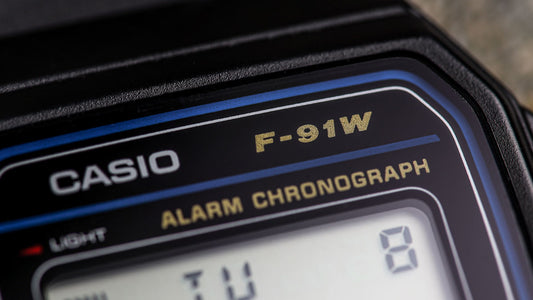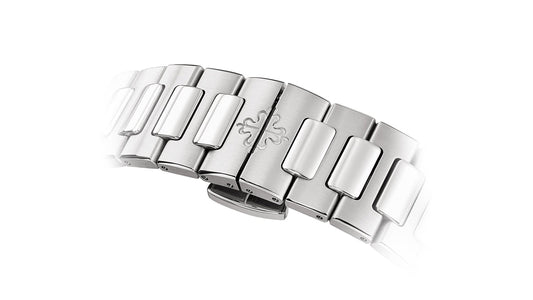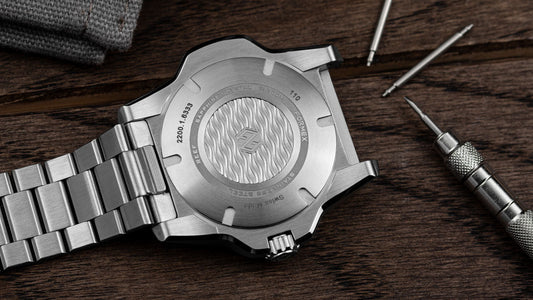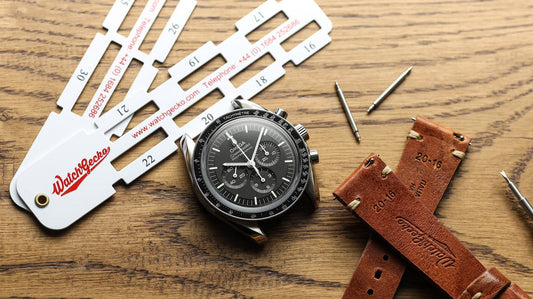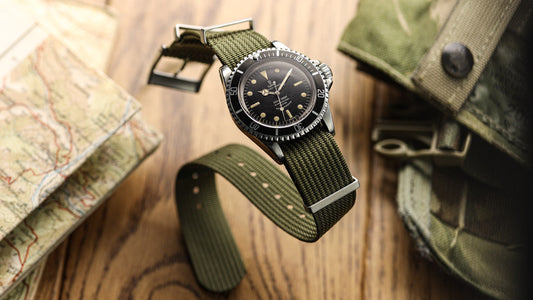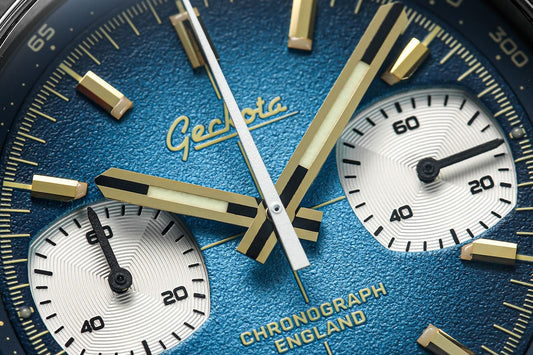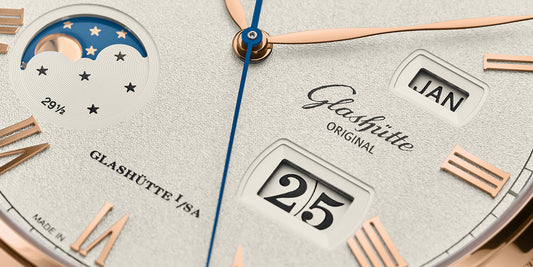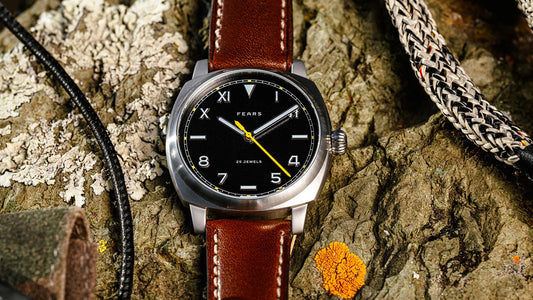How do you like your GMT watch – Office or Traveller?
GMT can be argued to be the complication of the moment. Many brands are offering new GMTs of all sorts and the argument rages on whether one is talking about an “office” GMT or a “traveller’s” GMT, and which one trumps the other.

MIDO Ocean Star - Image Credit: Dave Sweeting
For clarity, the two look and function in an identical manner, with 4 hands, usually with all of them centrally mounted. Hours, minutes and seconds of the time, displayed on a 12-hr dial exactly as almost every other watch out there. And the 4th hand is the GMT hand. It rotates a single time every 24 hrs to indicate a separate timezone. If you just wound them and watched them run, both types would seem to be identical. Right up to the point where you rub together your thumb and index finger before releasing the crown to set the watch.
In an “office” GMT, the first détente on the crown sets the GMT hand, usually in 1-hr increments. It moves independently of all the other hands.
The seconds détente hacks the watch and allows you to set the hours minutes and seconds (and date). The 24-hr hand moves too.
So, the argument goes, this method is best for tracking a remote office or two as you can switch the 24-hr hand to whatever timezone you like, whenever you like, whilst leaving the local time alone, unhacked. Hence “office” GMT for someone who is in the office tracking different timezones.

MIDO Ocean Star - Image Credit: Dave Sweeting
Conversely, the traveller’s GMT sets differently. The first détente on the crown allows you to set the hour hand, in one-hour increments. Not the GMT hand, but the hour hand of local time. All the other hands are left alone.
The second détente hacks the watch and allows you to move all the hands, in sync.
The reason this is called a “traveller’s” GMT is that the setting seems most suited to a traveller. They get on the plane in Heathrow, pulls the crown to the first position, and advances the hour hand 4 clicks, ready for his landing in Azerbaijan. The local time indicates where he is, leaving the GMT hand to indicate the time back home. The watch seems better suited to a traveller moving between zones, as that is the primary setting method.

MIDO Ocean Star - Image Credit: Dave Sweeting
Why is this important? Simply put, the list of companies offering traveller GMT watches is very small, and the list of those offering Office GMT watches is very long.
The former includes Rolex, Seiko and Tudor (only producing one very recently, the Black Bay GMT).
The latter? Everyone else. Well, everyone apart from a few Omegas, and their recent innovation, a non-GMT complication in the calibre 8500 movement family, which offers timezone-setting (1-hr increments) on 3-handed watches.
And everyone else usually offers the office GMT from using the exact same movement, the ETA 2893-2.
The Traveller GMT is often seen as being a more functional and exclusive complication. Some people even refer to it as a “true” GMT movement, but I think it is unhelpful as it adds a layer of unwarranted snobbery to the argument. It is also true that some of the Seiko watches that have this setting method use the Kinetic family of movements and are very modest, so the snobbery is unjustified.
But there was a total dearth of mechanical movements available to mid-level brands with the Traveller’s GMT feature. Not any more.

MIDO Ocean Star - Image Credit: Dave Sweeting
It was with some interest that I read that the Swatch group were developing the Powermatic 80 movements to have a traveller GMT feature, and I was very pleased to see that the Mido Ocean Star GMT, which is one of the first, was so attractive.
I should say that Mido are not active in the UK market. They have no dealer network or even an agent over here. Nor will they sell direct to customers. I did ask Mido directly, but they refused.
Having no local choice, I ordered my watch from a dealer in Germany, and got it for roughly the RRP that Mido so helpfully quotes in pounds on their website. This is not a sponsored review, I bought it with my money, and it duly arrived by DHL last week.
I have a strong preference for Traveller GMT watches, having had a few. All of them are gone now, except the Tudor Black Bay GMT, which is itself the reason I sold the others. To me, the Tudor GMT is the modern benchmark for the complication.
It succeeds the king of the GMT clan, Rolex’s 16710 GMT Master II, which has become impracticably valued over its original price, and remains beyond my means.

MIDO Ocean Star - Image Credit: Dave Sweeting
So it was with some trepidation that I sat down to properly compare the two, as the BB GMT is a favourite of mine. But it is an obvious comparison to use when assessing the Mido’s place in the world.
The simple truth is that they are designed with a specification that makes them brothers from different mothers.
They share 200m WR, 80-hr power reserve, traveller GMT, bezel, date and sapphire crystal.
Both are clearly in a dive-inspired case, with traditional tapered lugs, chamfered and finished with brushed facets and polished details for contrast.

MIDO Ocean Star - Image Credit: Dave Sweeting
Both use a very vintage inspired design palette assembled in a relatively modern manner. Both are quite austere, with simple repeated shapes, and touches of luxury only via the use of colour and applied indices.
But there are significant differences too. The Tudor sticks to a GMT bezel, colouring it in a subdued Pepsi-style in homage to its Rolex forebears. The bezel is 48-click, which limits it use to the primary scale. There is no lume on the bezel at all, only the dial and hands light up. There is also no corresponding 0-24 scale on the dial, the bezel is the only place to read the GMT hand against. The Tudor is also only variable by strap (steel, leather or military style). And it definitely leans to the vintage end of the spectrum.

MIDO Ocean Star - Image Credit: Dave Sweeting
Dare I say the Mido offers more here, with a 0-60 uni-directional bezel to add a further complication of minute timing. It is also 120-click (which would have been better on the Tudor and was used on the previous Rolex versions, being the lowest common denominator of 24 and 60) and it has a high gloss ceramic insert with a lume pip, rather than the simple alloy insert on the Tudor. The bezel action is crisp and precise, with good alignment and minimal play. The top surface of the ceramic insert is also fascinating. Is it black? Not quite. Blue? I don’t think so. Slate grey? Perhaps that is as near as I can describe it. It both compliments and contrasts with the dial and hands very well, and as with many darker tones, the colours change in different lighting. The Mido also has a fixed 0-24 scale on the shallow-sloped chapter ring, executed in black and blue to differentiate day and night.

MIDO Ocean Star - Image Credit: Dave Sweeting
This chapter ring is what has inflated the size of the Mido compared to its simpler Ocean Star dive watch cousin, raising the diameter from just under 42mm to 44mm. This increased size was the cause of my main concern when ordering. 44mm is bigger than anything else in my collection. But with a lug to lug just under 50mm and a thickness of 13.5mm, the 44mm dimension overstates how this feels on the wrist. The watch head is also 107g on my scales, fairly light for the size. The relatively short, downturned lugs make this comfy on my 7 ¼” wrist. But I think you might struggle to wear one if your wrist is significantly smaller than that.
There are options on the Mido too, 3 of them. The blue/black that I opted for (only on a fabric strap), a black version with orange GMT on a steel bracelet, and a Bi-Metal one, steel and gold PVD, on matching bracelet.
The Mido uses rectangular indices all round, apart from double squares at 12 and 6, and a single square to accommodate the date at 3. Even the 12-marker on the bezel is a square, albeit with a round lume pip within. The hands are folded, with a brushed centre section and polished edges. The H and M hands have rectangular lume sections on the outer ends, and empty windows on the pinion end. Both the GMT and the seconds hand have blue arrow heads.
The lume quality seems good too, with a strong glow as you transition from light into dark, and long-lasting readability. It is easy to differentiate the hands in the dark, as well as orientate the dial.
The repeated squares and rectangles all over the design give it a very coherent, clean, modern and functional appearance. It gels, including the serif-free font used for brand and numeration. As a result, it looks a lot more modern than the Tudor.

MIDO Ocean Star - Image Credit: Dave Sweeting
The sapphire crystal on the Mido is flat, and treated with AR coating inside and out. The AR works commendably well, and so far remains unmarked. Being flat, the crystal does give quite a sterile view of the dial below, there is no distortion you might get from a dome, or edge issues seen with a box crystal. It suits the austere nature of the design, but perhaps a low dome would have leant a little more class.
I like the little details touches when in motion too. The end of the hour hand just hovers over the inside edge of the date window as it passes 3. The minute hand tip reaches the inner edge minute indices. The ends of the second and GMT hands are at the outer edge of minute indices too. The widest part of the second hand’s lume passes perfectly over the inner edge of the hour indices. These are intentional and pleasing things to see.
And there are also a fair number of polished surfaces on offer.
The chamfers on the case corners, the castellated edge of the bezel, the crown, the surface of the ceramic bezel insert, the facets of the hands and indices.
These elevate what could otherwise look a little utilitarian into something smarter and even perhaps dressier.
These really do lend this watch an ability to dress up or down. Stick it on a military style, it looks great. Custom leather? No problem. Rubber? Go ahead. Only the most coherent of watch designs manage this feat of looking at home on almost any strap, with shirt and collar, or T-shirt and shorts.

MIDO Ocean Star - Image Credit: Dave Sweeting
The Mido does, much to its credit.
Personally, I think the Mido emerges from its comparison with the Black Bay GMT with its honour very much intact, and its reputation enhanced, especially as it is about one third of the Tudor’s budget. Not only that, but the detail that the comparison has forced me to think about makes it very much its own watch, and all the better for it.
Mido is producing some great watches at the moment. They are also about to launch what looks like a very nice 2-register chrono in black PVD. It is a brand to keep an eye on, even if they are only available from dealers abroad. Perhaps that will change soon.
To find out more about MIDO watches, click here.







